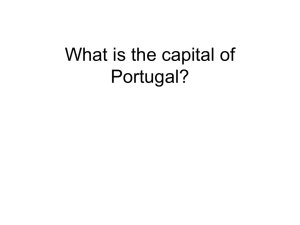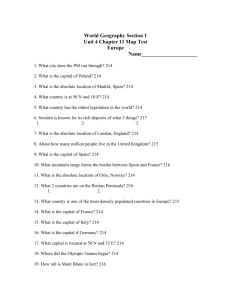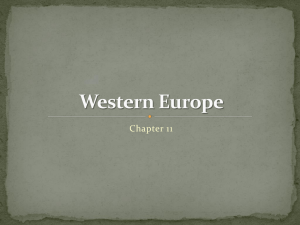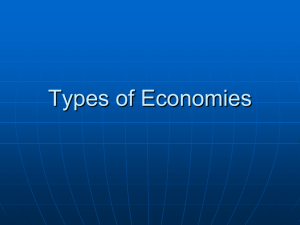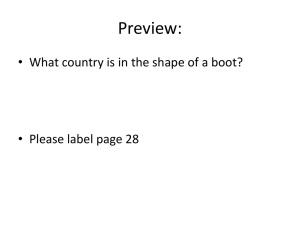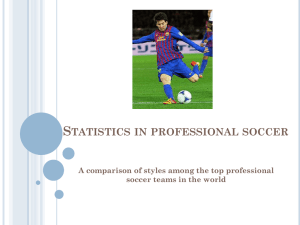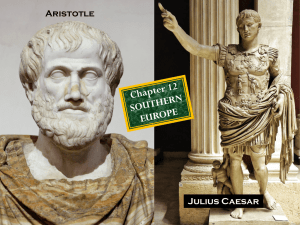World Regions in Global Context Europe 1) Which of the following is
advertisement
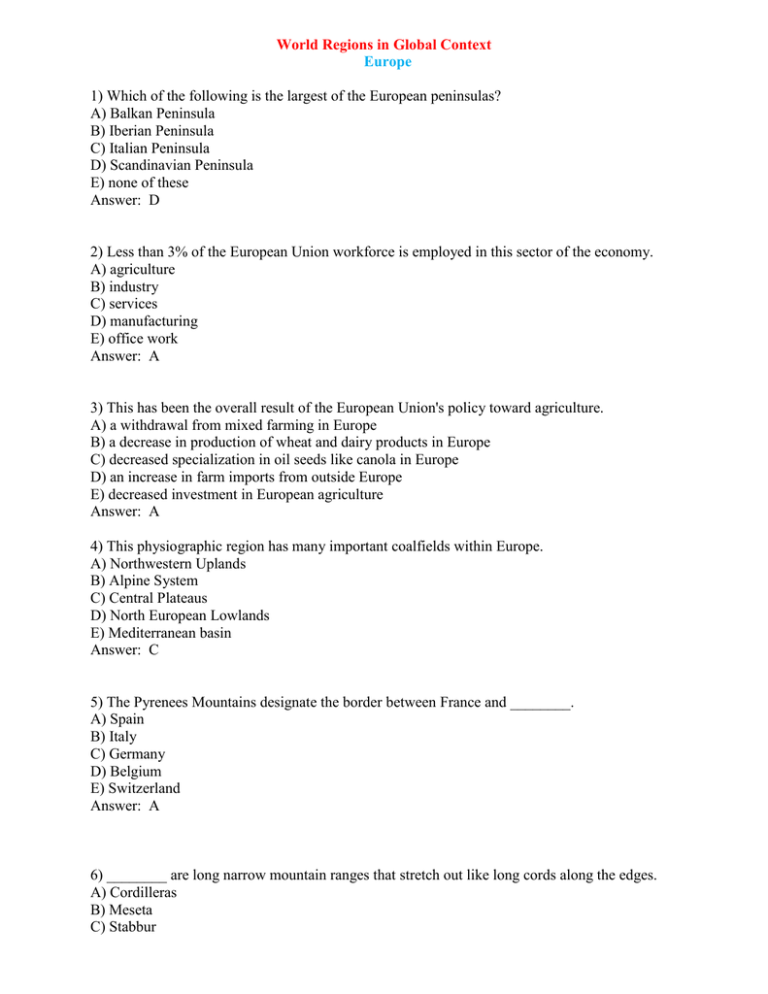
World Regions in Global Context Europe 1) Which of the following is the largest of the European peninsulas? A) Balkan Peninsula B) Iberian Peninsula C) Italian Peninsula D) Scandinavian Peninsula E) none of these Answer: D 2) Less than 3% of the European Union workforce is employed in this sector of the economy. A) agriculture B) industry C) services D) manufacturing E) office work Answer: A 3) This has been the overall result of the European Union's policy toward agriculture. A) a withdrawal from mixed farming in Europe B) a decrease in production of wheat and dairy products in Europe C) decreased specialization in oil seeds like canola in Europe D) an increase in farm imports from outside Europe E) decreased investment in European agriculture Answer: A 4) This physiographic region has many important coalfields within Europe. A) Northwestern Uplands B) Alpine System C) Central Plateaus D) North European Lowlands E) Mediterranean basin Answer: C 5) The Pyrenees Mountains designate the border between France and ________. A) Spain B) Italy C) Germany D) Belgium E) Switzerland Answer: A 6) ________ are long narrow mountain ranges that stretch out like long cords along the edges. A) Cordilleras B) Meseta C) Stabbur D) Altiplano E) none of the above Answer: A 7) Mistral winds blow down the Rhône Valley in southern ________. A) Germany B) France C) Italy D) Spain E) Poland Answer: B 8) Which country first developed polder landscape techniques? A) Switzerland B) France C) United Kingdom D) Netherlands E) Italy Answer: D 9) Most important European cities of today began as settlements established by this group. A) Muslims B) Greeks C) Romans D) Phoenicians E) Vikings Answer: C 10) During what period did innovations in technology and business bring Europe into a new merchant capitalist economy? A) 9th-10th century B) 11th-12th century C) 13th-14th century D) 15th-16th century E) 19th-20th century Answer: D 11) Spain and ________ used gold and silver from the Americas to increase their wealth during the colonial period. A) Portugal B) England C) France D) Germany E) Italy Answer: A 12) Which country was the first in oversea expansions? A) France B) Spain C) Netherlands D) Portugal E) Italy Answer: D 13) Industrialization came to the coalfield areas of northern France, Belgium, and Germany during this time period. A) 1790-1850 B) 1850-1870 C) 1870-1900 D) 1900-1920 E) 1940-1950 Answer: B 14) After an unsuccessful initiative program, this became the goal of COMECON. A) economic self-sufficiency B) mutual trade among the Soviet bloc C) a move to Chinese Communism D) export production for the West European market E) capitalist investment Answer: B 15) This is the best reason why Europe's population is growing so slowly at present. A) decline in birthrates B) increase in death rates C) out-migration to other regions D) AIDS infection E) Europe is actually growing rapidly at present Answer: A 16) What percent of Europe's population is approximately over 65 years of age? A) 9% B) 16% C) 25% D) 30% E) 45% Answer: B 17) Most European migrants over previous centuries have gone to this destination. A) the Americas B) Australia and New Zealand C) Asia D) Israel E) Africa Answer: A 18) What is the predominant religion in southern Europe? A) Protestantism B) Roman Catholicism C) Eastern Orthodox D) Judaism E) No one religion predominates in southern Europe. Answer: B 19) This is one of the major advantages of former COMECON members. A) cheap land and labor B) local markets for agricultural production C) well-developed communications and transportation infrastructure D) well-developed knowledge-based industries E) high levels of personal savings Answer: A 20) Within Europe, Germanic languages are mostly spoken in which region? A) Northwestern Europe B) Southern Europe C) Eastern Europe D) Russia E) the Balkans Answer: A 21) One of the largest and most successful growth centers within metropolitan Paris is called: A) La Defense B) Potsdamer Platz C) Londinium D) Hague E) Docklands Answer: A 22) A country that has a centralized, autocratic government and values nation and race over the individual is referred to as: A) communism B) democracy C) command economy D) fascism E) socialism Answer: D 23) All of these are major cities of Europe’s “Golden Triangle” except ________. A) London B) Rome C) Paris D) Berlin E) None of these are in the “Golden Triangle.” Answer: B 24) The Randstad, a densely populated, highly urbanized region, is located in this country. A) Sweden B) Belgium C) the Netherlands D) Germany E) Sweden Answer: C 25) After World War II, this German city was divided between two countries, one under democratic rule, the other under Communist rule. A) Bonn B) Dortmund C) Berlin D) Amsterdam E) Munich Answer: C 26) This is the best estimate of Europe’s contribution to the world’s aggregate GNP. A) 13% B) 23% C) 33% D) 43% E) 73% Answer: C 27) London is located on this river. A) Rhine B) Seine C) Elbe D) Thames E) Marne Answer: D 28) Paris is located on this river. A) Seine B) Rhine C) Rhone D) Po E) Marne Answer: A 29) This is the largest city in France. A) Paris B) Rome C) Madrid D) Brussels E) Lyon Answer: A 30) The “Southern Crescent” of Europe includes all these cities except ________. A) Paris B) Milan C) Turin D) Munich E) Zürich Answer: A 31) This was the predominant economic system in Europe before 1500. A) feudalism B) capitalism C) the welfare state D) fascism E) Marxism Answer: A 32) When was the Marshall Plan instituted? A) after World War I B) after World War II C) the end of Communism D) the Gulf War E) none of these Answer: B 33) Which of the following is defined as a national economy in which all aspects of production are centrally controlled by government agencies? A) command economy B) common market C) capitalism D) welfare state E) swidden Answer: A 34) "La Defense" is an example of a: A) 19th century suburb B) medieval city C) central business district D) new town suburban node E) none of the above Answer: D 35) What is “Balkanization"? A) the combination of territories held together by an authoritarian government B) the division of a territory into smaller and often mutually hostile political units C) the division of a territory into smaller and often mutually dependent political units D) the formation of federations of small political units E) none of these Answer: B 36) Which of the following led to attempts at ethnic cleansing in the late 20th century? A) Croat nationalism B) Muslim nationalism C) Serbian nationalism D) Basque nationalism E) none of these Answer: C 37) What does the German word gastarbeiter mean? A) German nationalism B) internal passport C) guest worker D) foreigner E) none of these Answer: C 38) What is the single most dominant feature of the Nordic European landscape? A) grasslands B) deserts C) forests D) plains E) cropland Answer: C 39) This is a semiarid, treeless, grassland plain. A) tundra B) steppe C) polder D) taiga E) bora Answer: B 40) Besides the Black Death, what was the other factor halting the “great medieval colonization?” A) swidden agriculture B) financing by princes C) the Irish Potato Famine D) collapse of the Roman Empire E) Little Ice Age Answer: E 41) The cost advantages that accure to individual firms because of their location among functionally related activities is called: A) economies of scale B) agglomeration economies C) subsistence economies D) growth pole economies E) nodal economies Answer: A 42) Which country was expelled from the Soviet bloc due to ideological differences? A) Bulgaria B) Czechoslovakia C) Hungary D) Yugoslavia E) Finland Answer: D 43) Xenophobia is: A) a hate, or fear, of Americans B) a hate or fear of religion C) a hate, or fear, of foreigners D) a love, or acceptance of foreigners E) a love, or acceptance of Americans Answer: C 44) Which of these countries never had a Communist government? A) Italy B) Spain C) Greece D) United Kingdom E) None of these countries ever had a Communist government. Answer: E 45) Beginning around 750 B.C.E. , the ancient Greeks developed a series of fortified city states called: A) poleis B) latifundia C) apparatchiks D) foggara E) none of the above Answer: A 46) A central business district is a central nucleus within a city, with mostly this kind of land use. A) residential B) commercial C) industrial D) recreational E) cultural Answer: B 47) In the steppe region of the North European Lowlands, what type of agriculture dominates the landscape? A) wheat B) sheep C) cattle D) corn E) fruit and vegetable Answer: B 48) The principal industry of the Alpine region is: A) sheep farming B) manufacturing C) banking D) fishing E) tourism Answer: E 49) Deep, bowl-shaped basins on mountainsides which are shaped by ice action are called: A) moraines B) cirques C) fjords D) tarns E) alluvial fans Answer: B 50) This mountain range is sometimes used to mark the boundary between Europe and Asia. A) Alps B) Carpathians C) Urals D) Pyrenees E) Apennines Answer: C 51) Loess is a fine-grained, extremely fertile soil. Answer: TRUE 52) The first wave of European industrialization was located in the coal fields of northern France, Belgium, and Germany. Answer: FALSE 7 53) World War II resulted in smaller ethnic minorities in Eastern Europe than before the war. Answer: FALSE 7 54) Most of the immigrants going to the Netherlands are from former colonies in Indonesia. Answer: TRUE 55) The United Nations Kyoto Protocol is a legally binding global agreement to reduce greenhouse emissions into the atmosphere. Answer: TRUE 4 56) Almost all Western Europeans live in a European Union member country. Answer: TRUE 3 57) Ukraine is a former Soviet republic which has successfully reintegrated with the rest of Europe. Answer: FALSE 3 58) All of the countries of Eastern Europe once had Communist governments. Answer: TRUE 7 59) Fjords are steep-sided, narrow inlets of the sea, formed when deeply glaciated valleys are flooded by the sea. Answer: TRUE Geography Std: 7 60) The original domestication of wine grapes seems to have taken place as early as 8000 B.C.E. along the mountains slopes of France and Spain. Answer: FALSE 61) The Dutch Muslim population of between five and six million is the largest in Western Europe. Answer: FALSE 0 62) Women in Europe generally have a significantly longer life expectancy than men. Answer: TRUE 63) Enclaves are culturally distinct territories that are surrounded by the territory of a different cultural group, whereas exclaves are portions of a country or of a culture group's territory that lie outside its contiguous land area. Answer: TRUE 2 64) Slavic languages dominate southern Europe. Answer: FALSE 0 65) All European States are now net migration countries. Answer: TRUE Match each country with its capital. A) Kiev B) Oslo C) Bucharest D) Riga E) Zagreb F) Madrid G) Paris H) Dublin I) Lisbon J) Sofia 66) Ireland 67) Portugal 68) Spain Section: Chapter 2 Geography Std: 1 69) France Section: Chapter 2 Geography Std: 1 70) Croatia 71) Bulgaria 72) Romania 73) Ukraine 74) Latvia 75) Norway Answers: 66) H 67) I 68) F 69) G 70) E 71) J 72) C 73) A 74) D 75) B 76) Discuss demographic change in Europe since 1900. What are some of the factors that led to a population implosion during the 20th century? What are some of the strategies European countries currently employ to offset low population growth rates? 77) What was the Cold War? When did it begin and end? Why did the Soviet Union establish a buffer zone in Eastern Europe? 78) Discuss Muslims in Europe. Where are the majority of Europe's Muslims located? What events contributed to the migration of Muslims to Europe? What are some of the problems Muslims face living in the largely Christian European realm? 79) What is meant by the phrase "European Dream"? Compare and contrast the "European Dream" and the "American Dream." 80) What is the status of women in European society today? Is the status of women similar throughout all regions of Europe, or are some women more advantaged than others? 81) How did the Marshall Plan and COMECON help rebuild Europe after World War II? Which regions or economies benefited first? 82) When and where did wine production begin in Europe? In what regions of Europe does most of the wine production take place? How have the processes of globalization changed Europe's wine industry? 83) When and where did the western Industrial Revolution begin? What fueled this revolution? In what manner did this revolution diffuse throughout Europe? 84) How has Europe benefited from its location and its major physical features? 85) What key inventions during the 15th century through the 17th century helped European merchants establish the basis of today's global economy?
